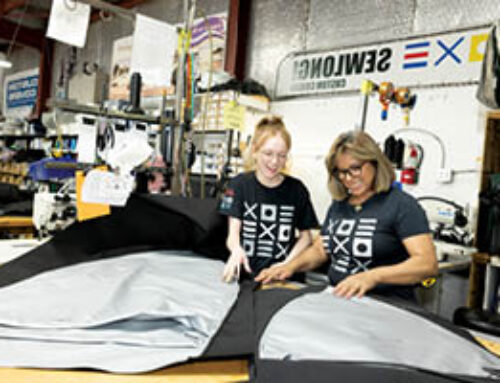Build your brand
The marketing power of a strong brand identity will boost sales and profits.
By William J. Lynott
Think of one of your favorite name brands. Whether it’s a professional product for use in your business or a favorite product for your personal use, chances are you chose it because you’re comfortable with it; you have a mental image of that product and the company behind it. That’s what brand identity is all about.
Major companies go to great lengths to build and protect a unique brand image because they know the marketing power of a positive brand identity, especially in a difficult economy. However, building a brand identity isn’t just for the biggest players. Every business can enjoy the extraordinary marketing power of a strong business image.
Exactly what is a brand? It’s more than a logo on a business card or the sign on the front of a building. It’s the promise that a business makes to its prospects and customers. It identifies the ways in which its products and services differentiate it from its competitors. Simply put, a brand is the image that a business projects in the hope of developing brand loyalty.
The brand identity for your business is the mental image you create in the minds of your customers and prospects. Your brand is your business personality. It can be a powerful marketing tool, a drag on your sales and profits, or anything in between. That’s why you must take control of your brand identity. When you develop a strong and positive brand image, your target customers will develop an emotional attachment to your products and services. They’ll become loyal in much the same way that you are loyal to your favorite brands.
It isn’t necessary for you to take the time and resources to create a brand image that will be recognized the world over. It’s only necessary for you to create the kind of image that will dominate your little piece of the marketing world.
Here are seven steps that will help you to build the kind of brand identity that will boost your sales and profits on a permanent basis:
Separate yourself from your competitors.
The first and one of the most important steps in creating a strong brand identity is determining what makes your marine fabrication business unique. Begin by analyzing your major competitors. Look for their strong selling points and ways that you can differentiate your services from the others.
The next step is evaluating your own strengths and combining them to form a unique identity—a marketable image for you and your business. Perhaps you’ve been in business longer than your competitors have, or maybe your personnel are well-trained specialists known for their skill and accuracy in filling orders. Perhaps you have highly knowledgeable salespersons who take pride in their knowledge of marine fabrics and how they can use that knowledge to best serve the customers’ needs. Perhaps your equipment is a model of state-of-the-art efficiency and safety.
Whatever your marketable strengths, write them all down, study them, and then determine how you can combine them to separate yourself from your competitors. Once you’ve sold yourself and your employees on why you are the best choice for customers who require the utmost in professional know-how, you must focus your marketing efforts on ways to promote this image to your customers and prospects.
Take action on something that most of your competitors only talk about.
Even though the focus of your business is marine fabrication, you sell your products to people, not to objects. All of the Harvard Business School expertise in the world is no substitute for an understanding of that basic business principle.
The most effective, least expensive, branding technique for any business is an uncompromising commitment to customer satisfaction. Making certain that every one of your customers has positive feelings about you and your business will turn those customers into walking advertisements.
Employ strong visual elements.
A major part of brand image is visual recognition. Science long ago recognized that humans remember what we see far longer than what we read or hear. That’s why are favorite major brands have a highly recognizable visual image.
A basic visual image for your business calls for an esthetically pleasing logo, which may or may not be a stylistic rendering of your company name. The logo in itself is not your brand, but it serves as the anchor for that all-important visceral image that is part of every successful brand identity. Once you create your logo, you must use it on all business cards, letterheads, envelopes, trucks, building signs, and anything else visible to the public, all with a consistent visual image. You can extend these essentials to include a website, a brochure, or any other professionally designed pieces. To embed your brand identity in your market area, you must use it consistently in every visual item you produce.
Make sure that all of your visual elements are unique to your business and that they will not be confused with those of a competitor.
Harness emotions.
All successful brand images have a large emotional content. While it’s important to make solid use of the purely rational in developing reasons why prospects should look to you when they need your products, it’s essential that you remember the power of the heart and mind in buying decisions. Scientists tell us that emotion is a more powerful system in the brain than the rational system. That’s why it’s important to try to influence as many positive emotions as possible at every step in building your unique brand image.
Utilize the power of repetition.
Repetition is an important part of building a strong brand identity. Marketing experts say that it takes six or more “impressions” for potential customers to remember and connect with a business. That’s why those annoying TV ads are repeated. Consistent and repetitive use of your visual materials will help to build an enduring and powerful brand for your business. Simple efforts, such as employees passing out your business cards or brochures at every possible opportunity and asking satisfied customers for referrals, will help to harness the power of repetition.
Travel branding roadways.
Once you’ve created your brand image, it’s important to make sure that it reaches your prospects and customers. The available branding roadways are almost unlimited, but for a business like yours, it’s important to utilize the least expensive. Advertising campaigns in industry media are fine for those who can afford them, but for businesses on a limited budget, there are many effective alternatives. Among them are such techniques as regular emails to people who have visited your website, occasional postcard mailings to past customers, a presence on social media, and asking satisfied customers to spread the word.
Live up to your new image.
Once you create and support your brand identity, it will work for you by helping to develop new customers 24 hours a day seven days a week, but only if you live up to the promise you have created. The time and effort that you’ve invested in branding your business will be for naught unless you and your employees remember that branding is about meeting expectations, not just creating them.
If you fail to meet the expectations created by your new brand identity, your customers won’t come back or recommend you to their friends.
William J. Lynott is an Abington, Pa.-based freelance writer who specializes in business management and finance.
7 steps to successful branding
- Separate yourself from your competitor
- Take action on something that most of your competitors only talk about
- Employ strong visual elements
- Utilize the power of repetition
- Travel branding roadways
- Live up to your new image
- Harness emotions
 TEXTILES.ORG
TEXTILES.ORG 






